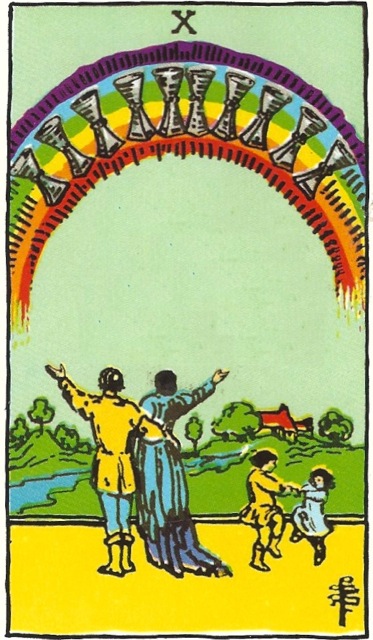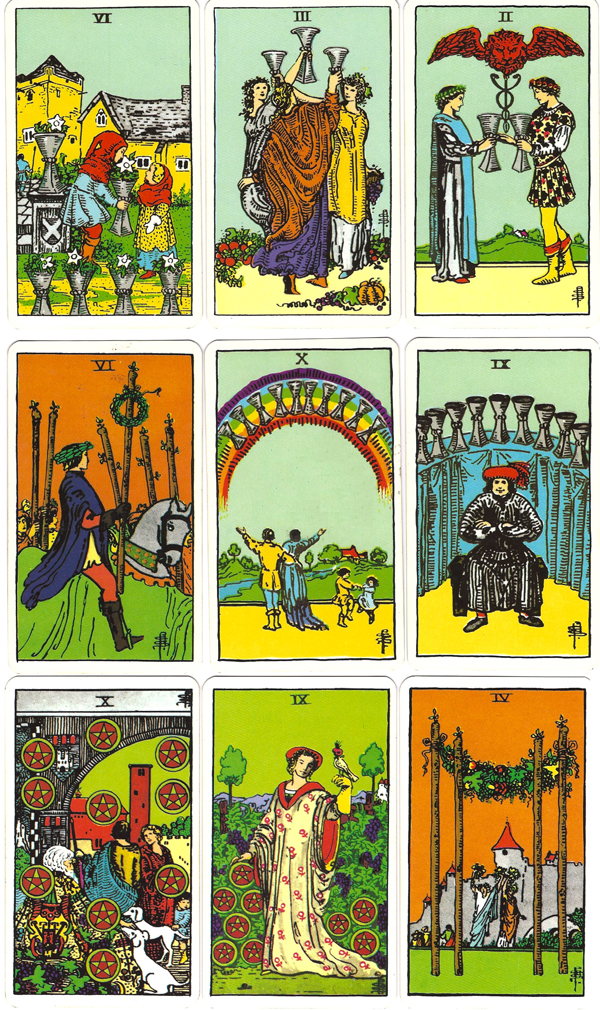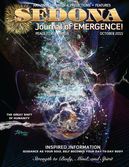
Secret Order of the Tarot
by Nori Muster
The tarot is a mirror for our world, including all of its highs and lows. The symbols of the tarot deck, notably the Major Arcana, represent archetypal themes. These symbols sometimes show up in dreams, or the dreams follow a similar theme. They are:
Fool, Magician, High Priestess, Empress, Emperor, Hierophant, Lovers, Chariot, Justice, Crone or Hermit, Wheel of Fortune, Strength, Hanged One, Death, Temperance, Devil, Tower, Star, Moon, Sun, Judgment, and World.
Any good tarot dictionary offers explanations for these archetypal themes. If you buy a tarot dictionary, be sure to look for one that works from a psychological (rather than superstitious) perspective. A good tarot dictionary is the Motherpeace tarot, by Karen Vogel and Vicki Noble. There are also many others.*
This essay offers a new interpretation of the tarot deck, and comprises a secret order of the tarot, tracing the meaning of the cards from the heavens to hell.
Contents
Divine Influences
Archetypal Forces
Archetypal Roles
Blessings from the Higher Realms
Joys of Human Existence
The Earthly Families
The Five Livelihoods
The Hanged Man and his Twelve Disciples
The Tower and its Twelve Victims
Feed Your Mind with Healthy Images
Divine Influences
The Major Arcana represent archetypal forces in life, and the highest and most abstract forces that control our lives are those that concern our universe. They are:
The Star—faith, inspiration, fulfillment, spiritual love
The Moon—deception, strangeness, darkness, the unknown
The Sun—success, warmth, goodness, happiness
The World—completion, perfection, success, fulfillment
These are powerful images that signify important issues in your questioner's life.
Archetypal Forces
Cards of the Major Arcana also represent the strongest archetypal feelings in life. Archetypal means that these forces touch every soul in one way or another, shaping our reality.
The Chariot—the experience of life coming for you
Strength—ability to get through the current circumstances
The Wheel of Fortune—destiny and fate, decisions
Justice—the repayment of karma due
Death—life's changes, including rebirth
Temperance—balancing the strong forces of life
Judgment—each soul's reckoning at the time of death, or in death-like crisis
When these cards show up in a reading, it means the questioner is dealing with powerful forces that signify major life events.
Archetypal Roles
We all meet types of people in life, and the archetypal roles of teacher, religious leader, and so on, play out in each person's life according to life's established patterns. The tarot deck embodies these archetypal characters as:
The Fool—youth and naivety
The Magician—creativty and imagination
The High Priestess—wisdom, common sense, and intuition
The Empress and Emperor—abundance and worldly power
The Hierophant (priest)—ritual and dogma
The Lovers—love, harmony, emotion
The Hermit and the Devil may also belong in this category, but you will find them below. The Hermit is counted as one of the Hanged Man's disciples, and the Devil is counted as one of the victims of the Tower.
While these cards may represent the appearance of specific people in the questioner's life, more often, these symbolize forces awakening in the questioner, or dramas playing out in the questioner's life.
Blessings from the Higher Realms
The aces in the deck transmit the blessings of the higher realm into the earthly realm, in turn offering blessings to humanity. Aces signify new beginnings and completion of goals. If an ace comes up in a reading, the questioner has a good chance of achieving (or having recently achieved) a blessing. Each card has endless interpretations, but here is a quick synopsis of each card:
Ace of Swords—initiative, triumph, strength, power, prosperity, championship, love
Ace of Wands—creativity, work, beginning of a new successful project
Ace of Cups—abundance, fulfillment, cooperation, marriage, union
Ace of Pentacles—prosperity, bliss, material and spiritual riches
Having an ace in a reading is an auspicious sign for the questioner.
Joys of Human Existence
Nine cards of the Minor Arcana describe the joys of human existence. They are:
II of Cups—one-to-one communication
III of Cups—spontaneous joy of friends
VI of Cups—nostalgic memories of old times, places, and friends, soulmates
IX of Cups—satisfaction in accomplishments
X of Cups—happiness of family and home
IV of Wands—celebration
VI of Wands—recognition for success
IX of Pentacles—communing with nature
X of Pentacles—ancestry, sense of belonging, and wealth
If these cards come up in a reading, they show the daily contentment the questioner experiences, which makes life good.
The Earthly Families
The tarot deck is inhabited by four royal families. These have significance for the reader because they show the people or types of people currently influencing the questioner. Or they could be influences developing within the questioner. The royalty are:
Page, Knight, Queen, and King of Swords
Page, Knight, Queen, and King of Wands
Page, Knight, Queen, and King of Cups
Page, Knight, Queen, and King of Pentacles
Get to know each of these families so you can help the questioner recognize their special qualities when any of these cards come up in a reading.
The Five Livelihoods
The tarot deck contains five cards that show the various means of livelihood. They are:
VII of Cups—a dreamer looks for opportunities to engage in creative work
II of Wands—a man looks to the globe for opportunities for trade
III of Pentacles—clergy learn the trades of their faith
VIII of Pentacles—a craftsman works at making a pentacle
VI of Pentacles—a just leader gives sustenance to those who cannot provide for themselves
If one of these cards comes up in a reading, it may show what the questioner has been trying, or wishes to try, to earn a living.
The Hanged Man and his Twelve Disciples
The Hanged Man is the leader of twelve disciples of perplexities that plague humanity. The Hanged Man represents suspension, tension, apathy, indecision, and other undesirable emotional situations, and his disciples elaborate on the negative emotional states. They are:
The Hermit—a seeker who remains alone, a stranger
VII of Cups—a man rejects good that is offered
IV of Cups—a man sits under a tree, ignoring a celestial blessing
V of Cups—a man laments three spilled cups, while ignoring two that still stand
II of Pentacles—a man balances two Pentacles with difficulty representing stress
IV of Pentacles—a man holds a pentangle greedily, unable to share or enjoy his wealth
VII of Pentacles—a man laments lack of productivity in his garden
II of Swords—a blindfolded woman must balance the powers of decision, duplicity, stalemate, or affliction
III of Swords—three swords pierce a heart, representing lost love, jealousy, or sorrow
IV of Swords—a man rests in peaceful repose, as if dead, representing abandonment, exile, disease, or loss
VIII of Swords—a blindfolded and bound woman surrounded by swords, represents crisis, bad news, imprisonment, or domination
IX of Swords—a person sitting up in bed crying in despair
These cards may help questioners understand the nature of their emotional burdens. Many of these cards have positive indications as well, so learn the cards to offer positive suggestions for questioners who appear to be stuck in one of these ruts.
The Tower and its Twelve Victims
The Tower represents rapid change that brings lack of stability, material loss, and suffering. The Tower's twelve victims elaborate on the effects of disaster. The twelve victim states of the Tower are:
The Devil—temptation, mind control, and victimization
III of Wands—a man looks out with trepidation at what will happen next
V of Wands—five men fight with their wands, showing unmet needs, strife, violence, and struggle
VII of Wands—a man defends against adversaries
VIII of Wands—eight wands fly across the sky signifying hasty decisions that may lead to failure
IX of Wands—a man stands on the road defending against enemies
X of Wands—a man carries a heavy burden of ten wands
V of Pentacles—two beggars pass beneath the window of a church, showing error, failure, poverty, and loss
V of Swords—a man takes the fruits of an ill-fought battle, bringing him infamy, dishonor, and weakness
VI of Swords—a boatman takes away a mother and child, signifying loss, anxiety, and separation
VII of Swords—a thief attempts to steal away with other's swords; dishonesty, politics
X of Swords—a man lays dead with ten swords in his back, utter defeat, anguish, heavy weight, misfortune
These cards may help questioners understand how their suffering began.
Feed Your Mind with Healthy Images

These nine cards describe the joys of human existence.* They are:
1st row: nostalgic memories of old times, places, and friends, soulmates * spontaneous joy of friends * one-to-one communication
2nd row: recognition for success * happiness of family and home * satisfaction in accomplishments
3rd row: ancestry, sense of belonging, and wealth * communing with nature * celebration
All the images on the cards are symbolic, and symbols speak directly to your subconscious mind. Therefore, you can use these cards to feed your mind with positive ideas in the form of pictures. Meditating on these images will inspire your subconscious mind to create more joyful situations automatically without using verbal affirmations.
You can make the meditation even more powerful if you align your mood and feelings to the cards as you contemplate them. Draw in the details of the characters, scenery, colors, and feel the overall mood of each picture. Memorize these feelings until you can invoke them in your conscious mind at will.
For best results, avoid any feelings of inadequacy, despair, jealousy, resentment, or other negativity that might confuse your message to your subconscious mind.
Keeping positive images fresh in your memory acts like a magnet to bring more positive situations and opportunities into your life.
About the author
Nori Muster is an art therapy researcher, with a Master of Science degree in Interdisciplinary Studies from Western Oregon University. She has lived in Arizona, since 1970, and has used the tarot and iChing for mind-body-spirit healing since the 1960s. She is the author of Dreaming Peace: The History of Positive Thinking, and other books. Her website is Surrealist.org.

This essay originally appeared in Sedona Journal of Emergence, October 2015, pp. 74-76
Index